
Kuya Silver Intersects Multiple >1,000 g/t Silver-Cobalt Veins in Wide Mineralized Zone At Campbell-Crawford Target, Silver Kings Project, Ontario, Canada

Wide, high-grade 11.49 m mineralized zone grading 353 g/t silver, 0.11% cobalt expanding known mineralization along the Angus-McNamara Vein System
Five of seven drillholes intersected significant, visible silver-cobalt mineralization with best intersection of 1,372 g/t silver over 2.36 m in hole 24-SK-23
Kuya Silver Corporation (CSE: KUYA) (OTCQB: KUYAF) (Frankfurt: 6MR1) is very pleased to announce the second set of drilling results from its 2024 drill program at its wholly owned Silver Kings Project, Ontario, Canada. This batch of drilling has been focused on testing the extent of the mineralization associated with the bonanza-grade silver-cobalt Angus Vein, first discovered in 2023. Several wide zones of high- to bonanza-grade mineralization have been intersected along a corridor between the flexed Angus and McNamara veins and connecting “ladder” veins and this flexure zone demonstrates significant potential for grade and tonnage (by Cobalt mining camp standards), with other suspected comparable, mineralized flexure zones nearby.
Highlights
- High to bonanza grade silver-cobalt mineralization intersected in several veins in a flexure zone between parallel Angus and McNamara veins (Figure 1, 2, 3, Table 1)
- Five of seven drill holes at Campbell-Crawford intersected significant, visible silver-cobalt mineralization
- Angus Vein zone intersected 1,372 g/t silver over 2.36 m within wider zone grading 353 g/t silver, 0.11% cobalt (380 g/t AgEq*) over 11.49 m
- McNamara Vein, previously untested in the ideal horizon, assayed mid-grade mineralization outside of flexure zone (92 g/t silver, 0.07% cobalt [110 g/t AgEq*] over 0.84 m)
- Connecting ladder veins, which may significantly increase the volume of mineralized material between the two main veins, yielded 28.6 m wide mineralized zone grading 107 g/t silver and 0.08% cobalt (125 g/t AgEq*) including:
- Upper vein: 1,540 g/t silver, 2.41% cobalt (2,127 g/t AgEq*) over 0.40 m within larger zone grading 322 g/t silver and 0.25% cobalt (382 g/t AgEq*) over 4.00 m
- Lower vein: 1,530 g/t silver, 1.93% cobalt (2,000 g/t AgEq*) over 0.40 m within larger zone grading 480 g/t silver and 0.30% cobalt (556 g/t AgEq*) over 2.90 m
- Widths of high-grade zone at Campbell-Crawford target in progress of being defined, with open potential at depth
- This pipe-like structure is at least 30 m wide, approximately 40 m long, with high-grade mineralization tested to 20 m depth; the structure remains open vertically with historic potential estimated at 100 m
- Drilling is in the early stages of definition drilling and additional drilling is required to develop a mineral resource estimation of this zone
- Indications of additional untested zones along trend and room for expansion of mineralization
- Zones are defined by detailed surficial geophysical surveys and 3D structural and lithological modelling
- Drilling, which is ongoing, is testing the grade, density and distribution of these newly-recognized ladder veins
David Lewis, Kuya Silver’s Vice President Exploration, commented: “In two years’ time and with limited drilling, we’ve taken a grassroots discovery to the edge of definition drilling and a potential resource estimation. This work confirms the high-grade nature of several of these veins, within a defined zone that remains open to depth, and with room for expansion with several similar untested targets nearby. I’m extremely proud to be a part of the hard work that’s gone into this project and I’d like to sincerely commend my team for their efforts. If we’re successful in defining a resource at this property, it will be the first potentially economic discovery in the Cobalt mining camp in at least 50 years.”
“Ladder vein structures, like the one we’re outlining at depth, are extremely favourable exploration targets. They commonly host higher-grade mineralization, which is concentrated in a smaller area, and they may cluster. Similar structures are known to host gold deposits in northern Ontario and Quebec.”
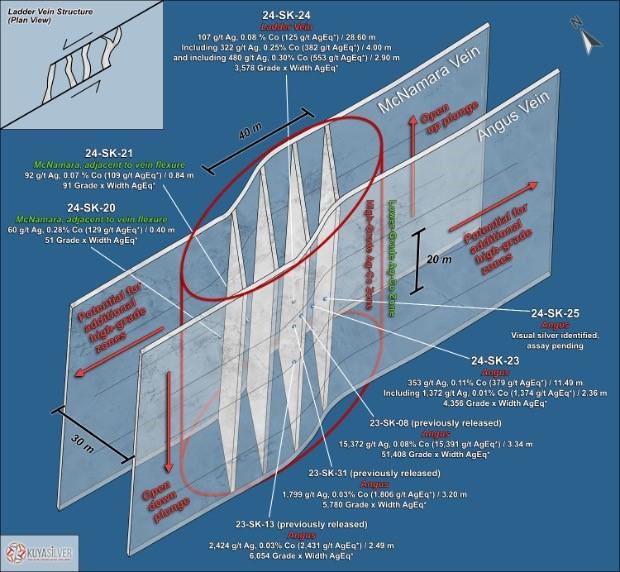
Figure 1: Conceptual diagram of a mineralized ladder vein structure within the ideal target horizon below the Nipissing Diabase at the Campbell-Crawford target. Flexures in the primary Angus and McNamara veins are interpreted to have formed structural extensional zones, resulting in secondary connecting veins, with high-grade silver-cobalt mineralization concentrated in this flexural zone. This cylindrical mineralized zone, tested to 20 m depth, is estimated to be 30 m x 40 m and likely extends further to depth.
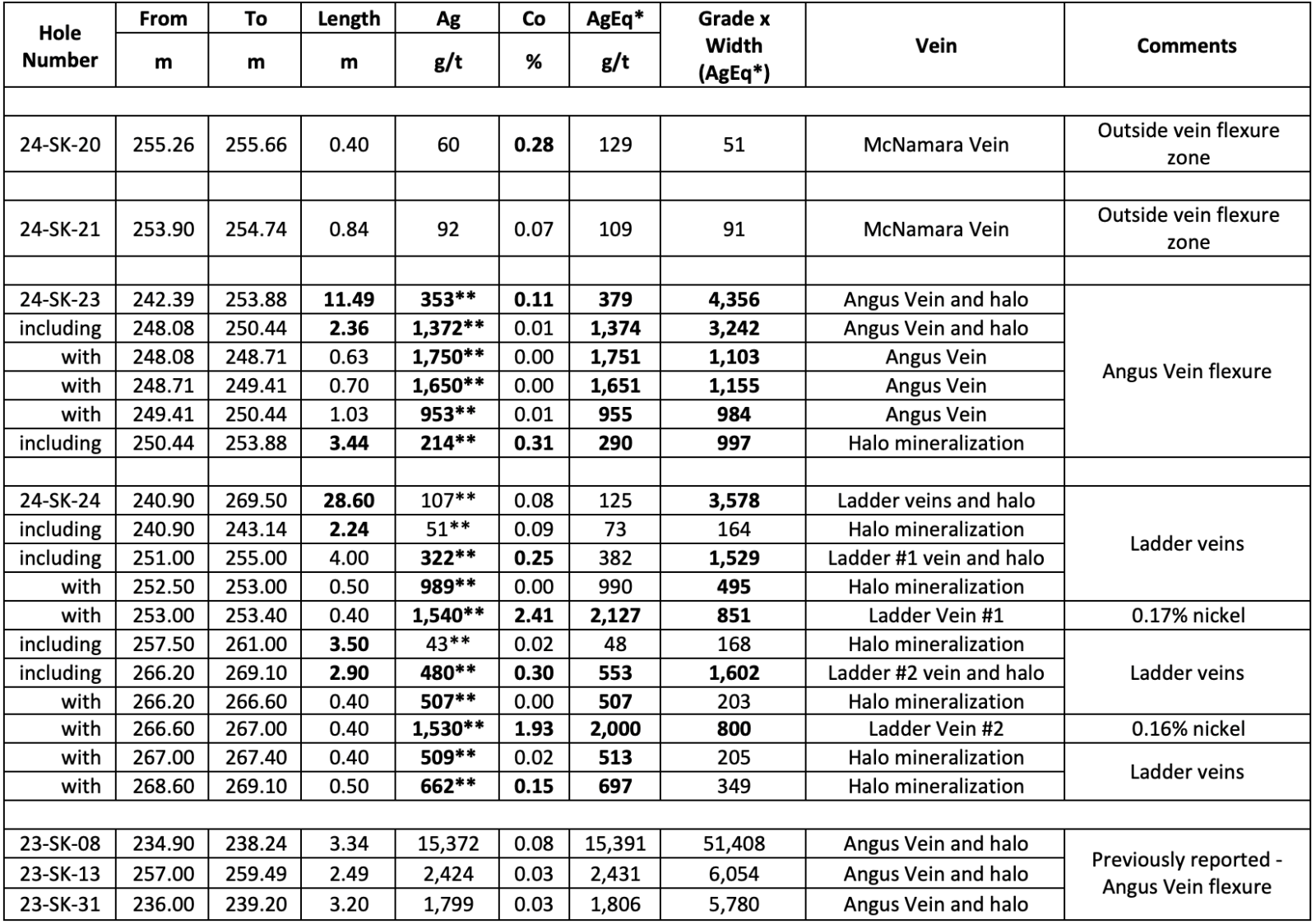
Table 1: Mineralized silver-cobalt intersections in current and previously reported drill holes from the Campbell-Crawford target. AgEq* (silver equivalent) grades were calculated using $30.33 USD / oz silver and $23,750 USD / tonne cobalt, with metal prices captured on January 28, 2025. Mineralized drilling intervals do not reflect true interval length. **Assaying by Screened Metallics was conducted on high-grade, visually identified silver mineralization.
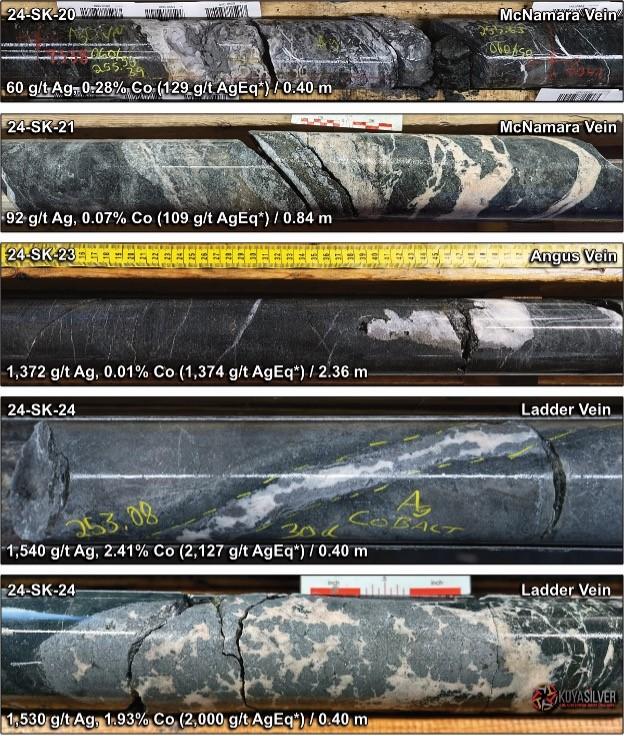
Figure 2: Core photographs of significantly mineralized veins intersected in the 2024 drilling program at the Campbell-Crawford target zone.
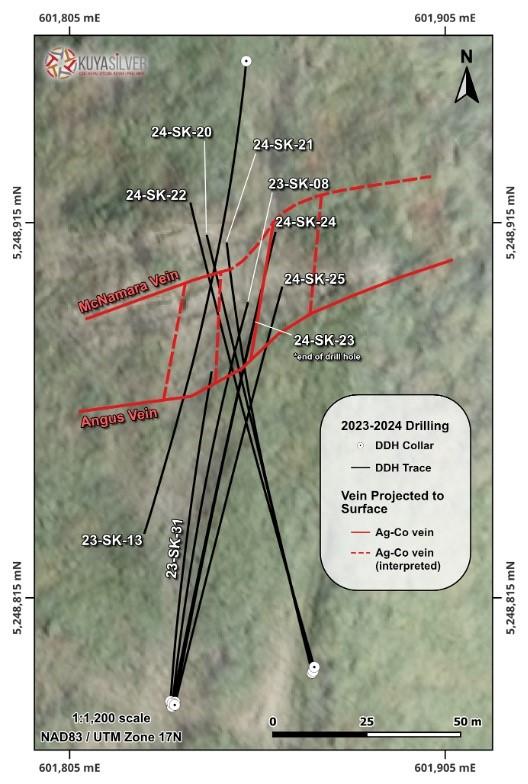
Figure 3: Vein geometry, projected to surface from 200 m depth, of major silver-cobalt mineralized veins intersected in 2023 and 2024 drilling.
Campbell-Crawford Target Expanded
The Campbell-Crawford target area has been the main focus for exploration at the Silver Kings Project, Cobalt, Ontario, since Kuya made a grassroots discovery of bonanza-grade silver-cobalt mineralization in hole 23-SK-08 (15,372 g/t silver, 0.08% cobalt over 3.34 m). Additional information can be found in previous Kuya Silver news releases (2023: February 23, March 15, April 4, May 30; 2024: January 11, January 29, June 24).
Drilling in 2024 at the Campbell-Crawford target area was targeting suspected high-grade mineralized “shoots”, which, based on Kuya Silver’s comprehensive review, understanding and reinterpretation of the distribution of silver-cobalt in the Cobalt mining camp, were thought to host a disproportionate amount of economic mineralization. Kuya Silver’s targets were developed based both on 3D-modeled veins and vein flexures (or bends) and an analysis of the vein chemistry. Flexure zones, especially between two primary veins or faults, can result in structural pull-apart structures and the development of secondary extensional connecting veins or faults, and these zones make excellent traps for mineralization (Figure 1 inset).
Flexures in both the E-W trending Angus and McNamara veins, suspected to host high-grade silver and cobalt, were modeled and drilled in the ideal horizon immediately below the lower Nipissing Diabase rock contact and are presented in Figure 1. Photographs of all significant veins intersected in this flexure zone, including previously released assay results, are presented in Figure 2. Maps showing the current vein geometry and other potentially mineralized zones are shown in Figures 3 and 4.
Due to the steep nature of these veins, drill holes are only able to effectively test single vein targets within the 200 m deep ideal target horizon, located below the Nipissing Diabase rock contact.
Angus Vein / Ladder Veins
Drill holes 24-SK-23, -24 and -25 were designed to test the high-grade Angus Vein flexure in a fan to the east from holes 23-SK-08 and -31, with hole -24 testing the interpreted high-grade shoot but up-plunge and above the diabase contact (Figure 1). All three holes intersected visible and pXRF-identified silver and cobalt in veins and stringers.
Hole 24-SK-23 pierced the Angus Vein zone eastward of hole 23-SK-08 and it intersected zoned silver-cobalt mineralization, with the silver-bearing Angus Vein in the centre of the interval. The interval graded 353 g/t silver and 0.11% cobalt over 11.49 m (from 242.39 m), with the central Angus Vein grading 1,372 g/t silver, 0.01% cobalt over 2.36 m (from 248.08 m).
Hole 24-SK-24 was drilled to test the up-plunge extension of the Angus Vein above the lower Nipissing Diabase contact. The weakly-mineralized Angus Vein was intersected above the contact in a fault zone but, further downhole, two strongly silver-cobalt mineralized veins were intersected within a broad mineralized zone. The mineralized veins grade 1,540 g/t silver and 2.41% cobalt over 0.40 m (from 253.00 m) and 1,530 g/t silver and 1.93% cobalt over 0.40 m (from 266.40 m) within a 28.60 m zone grading 107 g/t silver and 0.08% cobalt from 240.90 m. These veins are not part of the Angus Vein, and drill core orientation measurements suggest they trend N-S. These veins are interpreted as ladder veins between the Angus and McNamara veins, with vein density predicted to increase near vein flexures in an extensional ladder structure (Figure 1). Drilling in 2025 is set to test the grade, density and vertical extent of these newly recognized veins.
Hole 24-SK-25 intersected three moderately mineralized veins with assay results pending.
McNamara Vein
The McNamara Vein, which is known from surface and shallow historic exploratory workings, had never before been drilled by Kuya Silver in the ideal horizon at the lower diabase contact. Drill holes 24-SK-20, -21 and -22 were targeting an interpreted extension of a flexure of the McNamara Vein in a horizontal fan pattern and all three holes intersected the vein, which was significantly wider than the vein on surface, and confirming that the vein hosts silver and cobalt mineralization. The suspected vein flexure, which is interpreted as the main high-grade silver shoot, was not intersected in these holes and is suspected to occur along trend to the east.
Hole 24-SK-20 was drilled to test an interpreted down-plunge flexure in the McNamara Vein immediately below the Nipissing Diabase contact. A 0.25 m wide vein, rich in cobalt but weak in silver, was intersected in hole 24-SK-20. Hole 24-SK-21 was drilled clockwise to the intersection in hole 24-SK-20 and intersected a 0.30 m wide vein, slightly richer in silver. Hole 24-SK-22, drilled anticlockwise to hole 24-SK-20, intersected a 0.05 m wide vein.
Dimensionality of Angus/McNamara flexure zone
The oriented core drilling program at the Campbell-Crawford target, currently ongoing, has been beneficial in understanding the grade of mineralization as well as the geometry of the target zone, both crucial to future resource estimation. Three orientations of mineralized veins are currently known:
- Primary East-West trending veins including the Angus and McNamara veins. Mineralization in these veins increases near anticlockwise (Northeast-Southwest trending) vein flexures
- Secondary North-South trending veins including the newly recognized ladder veins that are interpreted to connect the primary veins (e.g. Angus and McNamara)
- Northwest-Southeast trending veins including the Toms and Moran veins
The configuration of drilled veins between the Angus and McNamara veins is most easily interpreted as an extensional ladder vein structure between the flexed main veins (Figure 1), forming a pipe-like structure that plunges (or stretches) to depth. These structures are relatively well-known in economic deposits, as they can increase vein density within the same potential volume of material and form a trap for ore minerals.
Current drilling at the Campbell-Crawford target constrains this zone to 30 m N-S between the Angus and McNamara veins, approximately 40 m E-W between suspected flexures, and at least 20 m vertical to depth (Figure 1). Historic mining suggests that the plunge may extend into the lower diabase contact and has the potential to extend 100 m below.
This drilling to date has identified some ladder veins, but there is a strong possibility for more of these connecting structures (Figure 3). Drilling, in progress, is set to test the number and distribution of these veins between the Angus and McNamara veins in the ideal target horizon. Furthermore, NW-SE trending veins, including the Moran and Toms veins, would also add to the overall vein total.
There is a strong possibility for additional mineralized jogs along the E-W trending Angus and McNamara veins (Figure 4). A detailed drone magnetic survey of the Campbell-Crawford property demonstrated that the mineralized Angus / McNamara vein flexure occurs within a 2VD (Second Vertical Derivative) magnetic low, and there are at least four additional and comparable geophysical patterns, along trend of the veins and within the property boundary, that are completely untested. Parallel geophysical anomalies may also be present to the north and south, also completely untested.
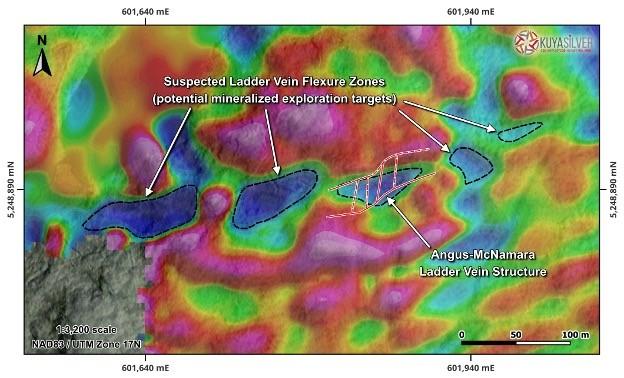
Figure 4: Detailed 2VD (Second Vertical Derivative) 160°-340° drone magnetic survey of Campbell-Crawford and Airgiod properties. 2VD zones of low magnetic response (blue, outlined in black) are interpreted to represent additional mineralized vein flexure zones.
Other Drilling Progress
Drilling at the Airgiod target has outlined the Nipissing Diabase contact at depth and has encountered some targets warranting follow-up work. Drill hole coordinates and orientations for all drill holes are presented in Appendix A.
Quality Assurance and Quality Control
The drill core samples were logged and sampled with limestone blank material and standard reference material added in sample sequence and/or following visual identification of silver or cobalt mineralization. The samples were cut perpendicular to veining by core saw and were secured in labelled vinyl sample bags. Samples were shipped to AGAT Laboratories in Thunder Bay, Ontario, or Val d’Or, Quebec, where they were weighed, crushed and pulverized.
At AGAT Labs (Calgary, Alberta), samples were digested by 4-acid and analyzed by ICP-OES (maximum undiluted detection limit of 500 g/t silver).
At SGS Labs (Lakefield, Ontario), samples were processed by 500 g Screened Metallics. This method is suitable for coarse native metals (e.g. gold, silver, copper, palladium and platinum) with no upper detection limit. Samples were screened to 106 microns and fire assayed.
When samples were analyzed for silver by both ICP-AES and Screened Metallics, the Screened Metallics results are presented. All QA/QC standards were acceptable and within two standard deviations of certified values, aside from a single blank sample.
Note: Portable X-ray fluorescence (pXRF) is a rapid and non-destructive analytical method used to precisely measure the point source (or spot) elemental composition of materials. Portable XRF measurements on mineralized veins were captured using a newly-calibrated handheld Olympus Vanta Max.
National Instrument 43-101 Disclosure
The technical content of this news release has been reviewed and approved by Mr. David Lewis, P.Geo., Vice President Exploration of Kuya Silver, and a Qualified Person as defined by National Instrument 43-101.
About Kuya Silver Corporation
Kuya Silver is a Canadian‐based, growth-oriented mining company with a focus on silver. Kuya Silver operates the Bethania silver mine in Peru, while developing district-scale silver projects in mining-friendly jurisdictions including Peru and Canada.
MORE or "UNCATEGORIZED"
Doubleview Extends High-Grade Domains at Hat: H099 Returns 438m of 0.40% CuEq Including 52m of 1.02% CuEq, Expanding Mineralization Envelope Around Conceptual Pit Vertically and Laterally
Doubleview Gold Corp. (TSX-V: DBG) (OTCQB: DBLVF) (FSE: 1D4) is pleased to announce assay results f... READ MORE
Cosa Closes Upsized C$7.5 Million Private Placement
Cosa Resources Corp. (TSX-V: COSA) (OTCQB: COSAF) (FSE: SSKU) is pleased to announce that it ... READ MORE
Americas Gold and Silver Closes US$132.25 Million Bought Deal Financing
Americas Gold and Silver Corporation (TSX: USA) (NYSE American: USAS) is pleased to report that it h... READ MORE
1911 Gold Closes C$23 Million "Best Efforts" Life Offering & Private Placement and Provides Corporate Updates
1911 Gold Corporation (TSX-V: AUMB) (FRA: 2KY) is pleased to announce that it has completed its prev... READ MORE
Endeavour Silver Completes US$350 Million Offering of Convertible Senior Notes
Endeavour Silver Corp. (NYSE: EXK) (TSX: EDR) announced today the closing of its previously announce... READ MORE












